Yankees
One of the funniest things about Spanish people's attitude towards Americans is that they refer to all of us as "Yankees." As a resident of the South, it is always surprising to get that particular label. It is especially funny when pronounced with a Spanish accent, which gives it a bit of a J sound at the beginning.
My professor mentioned this in my history class today, because he was talking about the origin of the term "moros," which many Spanish people use to refer to any Muslim person, but actually was the name of people from Mauritania, the north-western part of Africa. He was using the Yankee example to illustrate the general tendency to mistake the part for the whole. In another of my classes we talked about how a lot of people from Galicia (north-west Spain, next to Portugal), known as "gallegos" immigrated to Latin America at some point, and so now the term "gallego" has become synonymous with "español" (Spanish as in from Spain) in some parts of Latin America, even though Galicia is only one part of Spain.
Also, in the US we have the general impression of flamenco dancing as something very typically Spanish, when in fact it is only common in certain regions, particularly Andalucia in the South.
Anyway, this post didn't have too much of a point; I was just thinking about this stuff and I find it interesting. I guess this is part of that whole cultural awareness thing : )
Valencia part 2
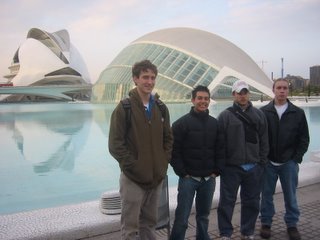
Now that I have had a good night's sleep I can finish up my tales of Valencia...
One very cool area we visited in Valencia is known as la Ciudad de las Artes y de las Ciencias (City of Arts and Sciences). It is a set of buildings, all of extremely modern design by the same architect. One of the buildings is an aquarium, one an art museum, and one an IMAX (yes!). Anyway, we didn't real
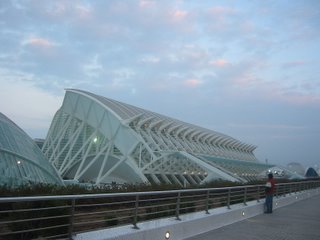
ly go in any of them, just kind of looked around and took pictures. The best part is the architecture anyway.
We also went to el Museo Fallero, which requires a bit of backstory. There is a huge festival sort of thing every year in Valencia known as Las Fallas. As I understand it, each neighborhood sponsors a "ninot," which is like a huge 3-D scene display, made of all kinds of stuff like cardboard and papier-mache and whatnot. Everybody who goes to see them gets to vote on which one they like best, and then, at the end of the week
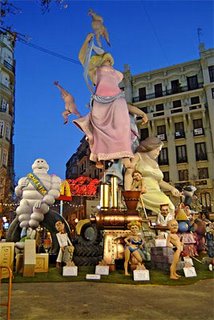
end, all of the ninots get burned (yep, like in a big bonfire) except for a couple of figures from the winning one, which go to the Museo Fallero. They are all really extravagant and each one has a theme; some are very political, some (especially those in the children's category) are based on some Disney movie or other. The museum was very interesting, but it is hard with some of them to understand what the whole display was about when you are only looking at a couple of figures from it. Also it seems like such a shame to burn so much good work just because it wasn't the very best!! Nonetheless it is a unique and interesting Valencian tradition.
Here is a website explaining it a little better (in English) if you are interested.
The thing I liked best about Valencia was not the city but the countryside to the South. Known as "la Huerta de Valencia" (I am pretty sure huerta means orchard...or something) it is a whole area covered with orange trees, almond trees, lettuce, rice fields, and probably some other stuff that I just didn't recognize. It is so pretty, in a barren kind of way. We totally drove around on these tiny country roads (some of them gravel o

r dirt) in our little bus, bouncing along at what seemed like an outrageous speed at the time. There were definitely a couple of times, probably when the water bottles and bags started falling out of the overhead compartments, that I thought my life might be in danger. Nonetheless, everyone made it back to the highway unscathed. We stopped at an orange grove to pick up oranges off the ground; I am pretty sure that was illegal, but there was at least a rule that we couldn't pick them off the trees... I don't know, but I was psyched, and ate several oranges, though they were really pretty tart, and I got my hands all messy. It was all part of the

fun : ) The almond trees (who knew? almonds grow on trees!!) were in bloom, so they were really pretty. The only picture I got, however, was out the bus window while we were careening along, so it is a tad blurry (but much better than some of the other ones I took!). I really like almonds in Spain for several reasons. First of all, the Spanish word for almond is
almendra, which, yes indeed, does rhyme with
Kendra! Secondly, lots of sweets are made with almonds here (they are not at all fond of peanuts), including
turron, which is a type of bar thingy common at christmas ti

me, but it is so good that if I lived here I would stock up at Christmas then eat it all year!!
This next picture is of some sort of irrigation thingy next to the orchard... I don't really have anything interesting to say about it, I just like how it looks, so there you have it.
So, that was pretty much it for our trip to Valencia. Tomorrow I am off to País Vasco, although we may get turned around due to snow on the roads. I promise a Lisbon post will be up shortly!!
Valencia part 1
So, now that I have finished my exams, here is the long awaited post about my Valencia trip a couple of weeks ago... I wouldn't want to get
too behind.
I went to Valencia as part of my program, with the whole group. Since there are only 8 students plus two professors, we went in this like 20-seat charter bus. It was pretty freaking sweet, and our driver, Manolo, is a little on the crazy side, which of course makes it more fun (but harder to read on the bus...)

Our first stop on the way was in Cuenca, this little town that has become synonymous in some parts of Spain with something that is stuck in the past or obsolete. It is famous for its "casas colgadas" - hanging houses - that are built right on the side of a cliff, hanging off the side. It is really a beautiful place, with great views of the countryside. Strangely enough, in addition to its old houses and tiny winding streets, it has a bit of a history with modern art. One of the old houses has been converted into an abstract art museum, and the stained glass
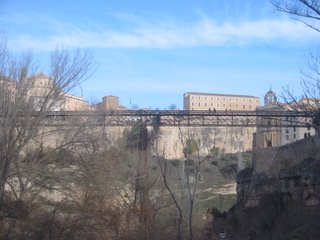
windows of the cathedral, which had to be redone relatively recently, were replaced with abstract designs. An interesting contrast, I think. We walked across this little pedestrian bridge to get across the gorge. It was a super long way off the ground, which made things interesting. Antonio, our art history professor, informed me that it was a tradition that the youngest person in the group (yep, that's me) jump off that bridge, or be thrown if unwilling to jump. Fortunately he didn't make much of an effort to follow through with that threat!

We also went to this other town called Alarcón that has a castle that has been converted to a "Parador," a kind of state-owned tourist hotel or something. That is it on the hill on the left. The little building at the right edge of the picture used to be some kind of lookout tower for the people who had the castle. Man! I wish I lived in a country that has random castles here and there... Anyway, we had refreshments in their café, and somebody checked on the prices to stay there: something like 200 euro a night, and they only have like 10 rooms total. So a little out of our price range...
Valencia itself was really nice. We were in the old part of the city, the cent
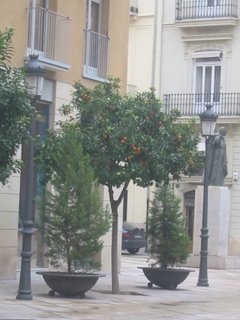
ral part, and there are lots of cool buildings, many which have been redone but keep the old style. There are also orange trees planted at regular intervals along the sidewalk. Their oranges aren't fit to eat, but they look quite charming. One of my classmates could not resign himself to simply believing what our professor told us about the oranges, and actually climbed up onto a trash can to "steal" one. After trying it, however, he informed us that it was "worse than a lemon," therefore confirming the rumor. Ok, that
is an orange tree in the picture on the right, and it has oranges on them! You just can't see them that well in the picture. Squint your eyes and have a little faith!
We went to lots of museums in Valencia, which is never my favorite part, but I suppose
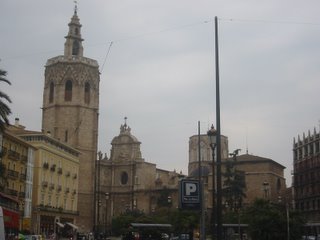
I am getting "culture" that I would otherwise avoid like the plague. We spent a lot of time in the Cathedral, which is, like almost every other cathedral I have seen, pretty and freezing cold inside. This one, however, has the added bonus of having a tower (in the picture at left - see how much taller it is than a four story building??), which for the low low price of 2 euro you can have the privilege of climbing. Ignoring the fact that Prof Sanchez wasn't going to climb it "because she did it once in her life and wasn't stupid enough
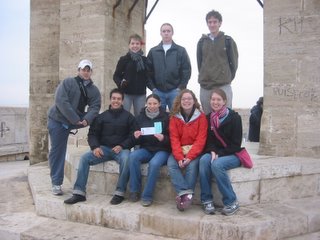
to do it again," all eight of us students trekked up nearly a gajillion stairs to get to the top, and I am still deciding whether or not the view was worth the days of sore legs (plus some time there were I thought I might meet my maker on an endless winding staircase in Spain). On the right is a picture of all of us at the top, proving that nobody just sat on the stairs halfway up and waited for the others to come down (not that i thought about doing that!!)
We also went to this HUGE mercado (market) in Valencia. For those who are as bad at geography as I am, Valencia is on the eastern coast of the Iberian peninsula, on the Mediterranean, and therefore has lots and lots of fresh seafood, a good portion of which seems to be sold in this market. Needless to say, it was smelly, and it was also very crowded (as much with tourists as with actual people buying things, I think). I saw all manner of seafood that I kinda wish I hadn't, especially those that were still alive... One thing I had never even heard of before (perhaps because I don't actually know the English word) is
sepia, which looks like squid but can be quite a bit bigger, and also kinda tastes like calamari but not as fishy. The market also had lots of fruits and nuts, which are also typical of the region (duh, Valencia oranges). (Ok confusing side note:
fruta is Spanish for fruit, but
frutos secos does not mean dried fruit, though one would think that since secos = dry. It in fact means nuts. So, if you happen to be in Spain and would like to buy a nice package of mixed dry fruit from a street vendor, do NOT be fooled by the ones marked "frutos secos mixtos." They are not your friends!)
We went to the beach (which is like a 20 minute train ride from Valencia) for a traditional meal of paella and arroz negro. Paella is a rice dish, soaked in some sort of broth so that the rice is really yummy, and with various other things in it, usually vegetables and some kind of meat. Often it is made with various types of seafood (particularly in Valencia), bu
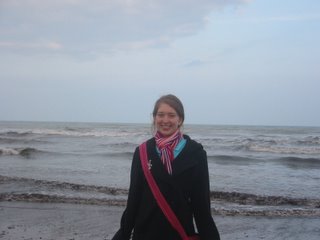
t we also had one made with chicken. My señora told me the first time she made it that it used to be the dish of like poor rural people in Valencia, and they would just put whatever leftovers they had in it, kind of like how (according to her) pizza got started.
Paella is actually the name of the shallow round iron pan with handles on the side that is used to cook the dish; people now often make the mistake of calling the pan a
paellera, assuming it is named for the dish instead of the other way around. Arroz negro (which I may have mentioned but can't remember) is sort of a variation on paella. It is also a rice dish (
arroz=rice), but it is made with calamari and what makes it
negro is - you guessed it - the squid's own ink. Mmm, tasty. I personally don't care for it that much, mostly because it tastes like calamari which I can only take in small doses. Anyway, we felt compelled to go touch the Mediterranean after lunch, which meant sandy shoes on the bus - ick!
Well that is about all I can write in one go - and I am sure nobody got through this whole post without a bathroom break! I will post the rest later. (Soon! I promise!) Glen, I hope this will hold your interest for a little while : )
Lesson of the Day
Alright, here is today's lesson, important for anyone in an urban setting: do NOT try to walk from one metro station to another unless you are POSITIVE you know how to get there, or you have a very detailed map with compass.
Yes, in fact that does come from personal experience... Today I was trying to get to the next metro station down from my school, and it seemed such a
shame to use one of my metro trips to get there when I just
knew it had to be around the corner. So anyway I set off alone, without my handy pop-out map that I usually carry but had the misfortune to forget this morning. For anyone who has ever witnessed my hopeless sense of direction in action, this was a recipe for disaster.
I definitely wandered around for an hour, practically in my own neighborhood, going back and forth at least twice between the same two metro stations, neither of which, obviously, was the right one. Fortunately the problem was not that I did not know where I was but rather that I did not know where the other station was, so I was able to find my way home when I decided I had had enough adventure for one morning. So, in summary, I never found what I was looking for and nearly starved to death for lack of cookies to replace the energy my aimless wanderings required. ::sigh:: On consulting my map once I got home, I discovered that I was in fact walking in the wrong direction, east instead of west. No wonder I couldn't find it!
So the moral of this story, of course, is to just get on the metro to get to an unknown station - the trains actually go straight to them!! Anyway, I am [supposed to be] working on a paper at the moment, so my extremely tardy post on Valencia, as well as the one on Lisbon from this past weekend will have to wait just a little longer. I promise they will be soon - I have lots of good pictures!!
Cooking Lessons
So everyone, it's been a while since I posted... hope you haven't all given up on me! I have several things to tell about, of course, but this post will be about the fabulous cooking lessons we had last week. I now, in theory, know how to make champiñones (mushrooms) with garlic, pan con tomate (bread with tomato), calamares fritos (fried calamari), and tortilla de patatas (kind of like an omelet with potatoes in it). I did actually make my own tortilla, and since it's like the easiest Spanish food to make, I think I could probably do it again. Oh, and sangria. Of course we learned how to make sangria! It was kind of cool, getting to learn something about cooking traditional Spanish foods, but I am generally pretty happy letting my señora handle

my meals...
This picture is of my professor (in pink) and another of the program supervisors watching as Taylor (in the Flamenco apron) demonstrates for the benefit of the audience how he would like to eat the squid he is preparing to fry. I particularly like the complete lack of surprise or disapproval on my professor's face... she is used to our antics by now : )














